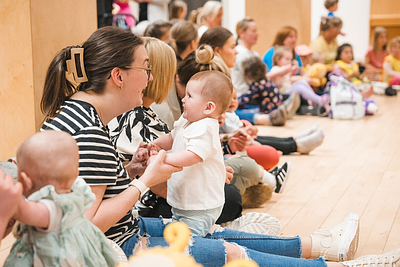Looking for all Articles by Early Years team?
How Peekaboo supports early literacy
Discover the many ways that a game of peekaboo is helping your baby develop their communication skills.

The language learning journey begins before babies are even born. Babies can hear and process sounds from inside the womb. As soon as they arrive in the world, they’re already familiar with their mother’s voice and are ready to communicate through gestures, sounds and facial expressions.
How does peekaboo help babies learn?
So many wonderful things are happening in a shared game of peekaboo. Firstly, you and your baby are probably face-to-face, allowing them to tune into your facial expressions and see your mouth clearly as you speak. This captures their attention and helps them to understand the ‘rules’ of the game, which mirror ‘turn-taking’ in everyday conversation. As they become familiar with the pattern of the game and the language associated with it (‘where’s daddy?’ or ‘where’s mummy?’…a pause of anticipation…and then ‘Peekaboo!’), your baby starts to anticipate what is going to happen next, building their excitement and keeping them engaged. They can read the excitement on your face as you reappear, and this is often mirrored with smiles and giggles of their own.
Repetition supports babies’ brain development
Peekaboo’s repetitive format is well suited to the developing brain. Babies learn best by experiencing things over and over. When the ritual of hiding and reappearing is repeated, babies start to tune in to your gestures and the tone of your voice to help them predict what happens next. Routines like this are one of the many ways that babies begin to make sense of the world and feel a sense of comfort and safety.
Seeing you reappear from behind your hands also helps your baby grasp the concept of object permanence, which is the understanding that things still exist, even if they can’t be seen. Psychologists such as Jean Piaget(this link will open in a new window) believe that there is a clear correlation between when a child recognises object permanence and their developing language skills. Once a baby is able to hold on to the mental images of objects or people in their head even when they can’t see them, they can begin to understand that everything else in the world can be symbolically represented by words and language too.
Learning to communicate
Playing Peekaboo can support other key pre-verbal skills, including turn-taking and maintained eye contact. There are natural points in the game which allow both adult and baby to communicate with each other; pausing after ‘Where's mummy or daddy?’ builds the excitement but also allows the chance for baby to ‘take their turn’ – this may be a simple gesture or smile, and for older babies a little vocalisation (babbling) or giggling. All of this interaction is perfect practice for having a conversation.
And of course, Peekaboo is a fantastic way to bond with your baby! You and your baby are enjoying a moment of shared attention and closeness which lets your little one know that they are loved.